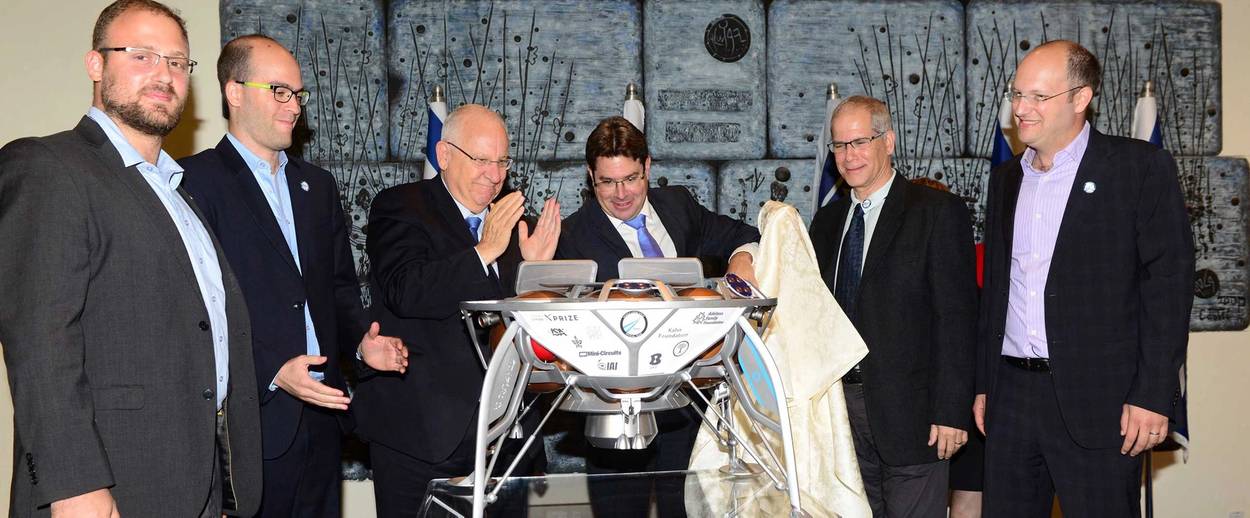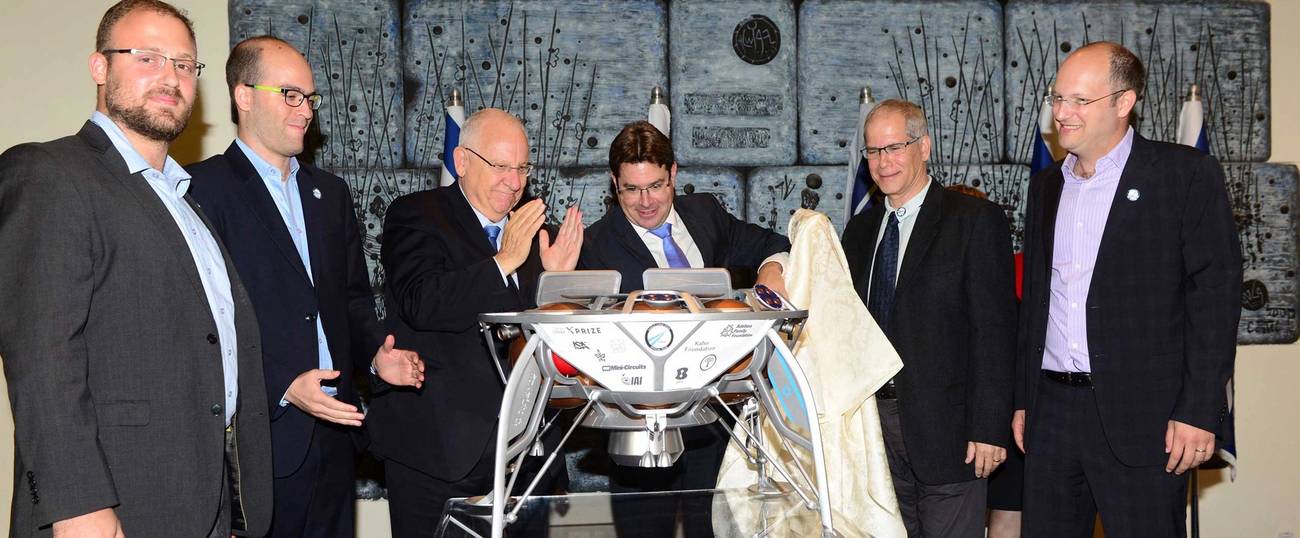No Man on the Moon
A scrappy Israeli team is trying to win millions for sending an unmanned mission to the moon




During the Holocaust, Yariv Bash’s grandfather was forced to build V2 rockets for the Nazi army. Now Bash has his eyes on a rocket of his own: one that will take the first Israeli spacecraft to the moon.
Bash is one of the three co-founders of SpaceIL, the Israeli entrant in the Google Lunar Xprize, an international competition to send the first civilian mission to Earth’s nearest neighbor. The first team to land an unmanned spacecraft on the moon, which then travels 500 meters and broadcasts images back to Earth, will take home a purse of $20 million.
With the strong support of the Israeli government and the backing of generous private donors, including billionaire investor Morris Kahn and casino magnate and political kingmaker Sheldon Adelson, SpaceIL is poised to make Israel the fourth lunar nation.
The planned SpaceIL mission, if it comes off, will also conduct a joint UCLA-Weizmann Institute of Science experiment to measure the changes in the moon’s magnetic field.
The end of December was the final cutoff for the competitors—scientists, engineers, and private entrepreneurs from around the world—to secure a launch contract on a rocket bound for orbit. Of the 29 teams who registered for the competition in 2010, five remain: the American Moon Express, Team Indus from India, Hakuto from Japan, the international Synergy Moon, and SpaceIL.
SpaceIL was the first team to obtain its ticket to the moon and will be launching its spacecraft on a Falcon 9 rocket produced by billionaire investor Elon Musks’s private aerospace company, SpaceX , by the end of 2017. As SpaceIL CEO Eran Privman explained, the agreement with SpaceX represents more than just a means of transport. “The fact that a serious company signs a contract with a group like us means that we know what we’re talking about,” he said. “That we’ve passed all their tests and that our craft stands up to all their requirements.”
However, SpaceIL’s moon mission almost didn’t happen, according to Bash, a bespectacled and balding 35-year-old electronics engineer and entrepreneur who recounted the story in the Tel Aviv offices of his drone-delivery startup, Flytrex. Having learned of the competition only in November 2009, two years after it began and only a few weeks before the deadline to register, he posted an invitation on his Facebook page: “Who wants to go to the moon?” Kfir Damari, 34, a friend and telecommunications engineer, answered the call. The next Saturday, the two met in a bar in Holon, just south of Tel Aviv, with aerospace engineer Yonatan Winetraub, and started plotting a way to the moon. On Dec. 31, the very last day to register, the three wired in the $50,000 entry fee and joined the competition.
“Space is the ultimate thing,” Bash said when asked what inspired him to join the Xprize moon race. “It’s something that is so hard to do, even today. In 2016, rockets still blow up; it’s still rocket science. This is one of the ultimate technological-engineering challenges.”
Despite other teams’ head starts, SpaceIL quickly advanced. It was the first team to design a landing craft, provisionally nicknamed “Sparrow,” that could use its engines to “hop” the required 500 meters over the moon’s surface rather than rely on a separate lunar rover to cover the distance. Seeing the elegance of this solution, Bash said, other teams followed suit.
One of the most important measures of SpaceIL’s success is its strong financial backing. Between government support—limited by competition rules to 10 percent of the project’s overall budget—and private donations, SpaceIL has raised $50 million of the $70 million that it estimates it will take to complete the mission; the launch alone costs $20 million. “Spacecraft don’t fly on hydrazine,” a common rocket propellant, Bash explained. “They fly on green fuel. If you look at the competition, we’ve raised more than double the next team.”
***
The Sparrow spacecraft is being designed and built at Israel Aerospace Industries, the country’s leading aviation and defense manufacturer. IAI, founded in 1953 by American Jewish pilot and engineer Al Schwimmer, can be considered Israel’s Lockheed Martin or Boeing, although, unlike the American companies, it is entirely government-owned. IAI produces Israel’s drones, aircraft, and satellites, as well as the Iron Dome missile-defense system.
Rather than the bright, white-booted, and sterile workspace one might imagine, though, SpaceIL’s electronics- and software-testing lab at IAI’s campus in the city of Yehud, just north of Ben-Gurion Airport, sits in a modified trailer on a dusty patch of ground near the parking lot. While the body of the craft will be assembled in the same high-tech clean room used for Israel’s Amos communication satellites, Sparrow’s computing and navigational guts are put through their paces here.
On a sunny winter day, SpaceIL software manager Asaf Lewin demonstrated some of the craft’s components: the 15-year-old computer, a three-tiered, functional stack of processors some 6 inches high, originally designed for a nanosatellite; a sensor to ensure the craft’s solar panels are always facing the sun; and a star tracker for navigation. It amounts to several million dollars’ worth of proven equipment that has already been tested in the radiation and cold of outer space.
The lab’s makeshift vibe is a perfect metaphor for SpaceIL’s upstart approach to the lunar mission. As Damari, the telecom engineer, explained, in order to keep costs down SpaceIL has decided to forgo IAI’s usual exhaustive checks and double checks on cameras and other non-mission-critical systems, building faster and cheaper than many had thought possible. This success has shown the potential for a civilian space industry in Israel. In the wake of SpaceIL, several local companies have established the Israeli presence in this growing field, including Effective Space Solutions, which is developing technology to return wayward satellites to their correct orbits, and Spacepharma, which offers zero-gravity space labs for scientific experiments.
“Showing that you can send a deep space probe for less than $100 million, that’s breaking a glass ceiling,” Bash explained. “It’s not only NASA and the European Space Agency that can do deep-space missions but also smaller countries, maybe large organizations. It’s opening up space a bit more to the Wild West.”
***
In their 2009 book Start-up Nation, Saul Singer and Dan Senor argued that mandatory army service and the nonhierarchical, creative culture of the IDF help explain why Israel has produced so many innovative technology companies. Bash, Damari, and Winetraub, all of whom worked in technological fields in the Israeli defense establishment before launching their project, would seem to be good evidence for their thesis.
But since the book was published, the outlook for Israel’s technology sector has become increasingly dire. The number of high school students studying high-level math and science has dropped dramatically, and the military and the private sector are experiencing a shortfall of thousands of qualified engineers, programmers, and technology professionals.
In 2015, in response to this crisis, Education Minister Naftali Bennet launched an aggressive program to expand the number of high school students taking a full course load in mathematics. While this and other programs have had some success, Ariel Heimann, director general of the Davidson Institute of Science Education at the Weizmann Institute of Science, said it’s not enough.
“I always say that Israel doesn’t export cotton and oranges anymore,” Heimann said. “What we export, essentially, is what’s between our ears. We need a lot of young people who will be scientists in the future. In every single factory, there have to be people who understand science, who understand chemistry, physics, biology, mathematics, and computer science.”
But 50 percent of the high schools in Israel don’t offer chemistry, according to Heimann. “There are not enough teachers, and not enough high-quality teachers,” he said. The new program for mathematics really works. But we need more students in physics, we need more students in chemistry. And that is not changing.”
Helping to reverse this trend is a key part of SpaceIL’s goal. Registered as an educational nonprofit, the team’s four full-time education staff, assisted by dozens of volunteers, have led workshops and delivered lectures to more than a quarter of a million children in schools all over Israel. Using the story of the mission, they are working to create an Israeli Apollo effect, akin to the spike in American children pursuing careers in engineering and science in the years following the Apollo program. The images of SpaceIL’s own moon landing, they believe, will inspire a generation of Israelis.
“We want to land the craft, but the vision is much bigger,” Damari said. “It is important to us that this is the first Israeli spacecraft and not the last.”
***
Like this article? Sign up for our Daily Digest to get Tablet Magazine’s new content in your inbox each morning.
Samuel Thrope is a Jerusalem-based writer and the translator of Jalal Al-e Ahmad’s The Israeli Republic.